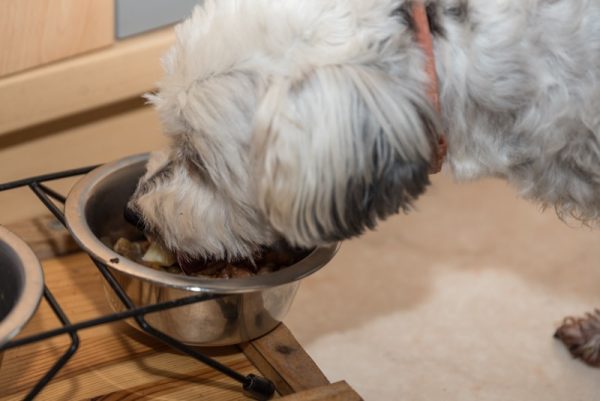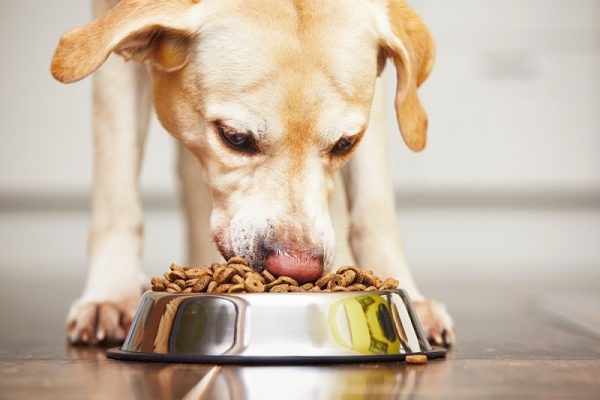In this article
Plastic is in the limelight—raising many concerns. As the pet market grows, so does the controversy about using certain products. But with so many plastic dog food packaging and food bowls still dominating the market, are they really so bad? Plastic bowls and containers are okay for dogs, but there are other options that are probably better and longer-lasting.
Here, we will explore why plastic might not be the best choice and suggest some alternatives—if you’re looking.

Concerns With Plastic Packaging for Dog Food
We are continually buying and using products packaged in plastic—from saran wrap to hard plastic containers. Dog foodsometimes uses plastic as the coating for dry dog food bags. Plastic is often also used for wet food options and fresh food storage containers.
So, it’s inevitable that you will see plastic-wrapped products marketed at dogs—from food to toys. So, what are the major concerns about plastic?

BPA
We’ve all seen the “BPA-free” advertising on plastic products, but what does it mean? BHA, or bisphenol A, is a chemical found in many commercial plastic, and can be very dangerous. BPA’s most common issue is infertility, but it can also cause cancer and a laundry list of other health issues.
If your dog’s food is packaged in plastic that has BPA in its composition, it can essentially leak into your pet’s food, causing adverse effects over time.
According to the Food and Drug Administration, BPA might be safe at very low levels, but there is no set guarantee.
Digestive Obstruction
One consequence of trusting plastic for dog food containers is the potential for consumption. All plastic could cause an obstruction inside the body, and it’s unable to break down in the system. If plastic pieces are torn off, or your dog gets into his food, you might not notice that they eat indigestible plastic.
So, if your dog accidentally consumes plastic, you could have some pretty high vet bills on your hands. If your dog is a major chewer, they might also love chewing on leftover plastic containers for food since it smells like a delicious meal and is texturally satisfying.
Choking
In addition to plastic being indigestible, it can also be a huge choking hazard. If the plastic is thin, such as saran wrap or plastic bags, it can wedge in the throat, causing suffocation.
Plastic can pose a choking hazard, and getting lodged in the airway can cause damage to the trachea and esophagus.

Absence of BPA
You might see pet food products rave about being BPA-free. But what does that mean? It usually means they just replaced the BPA with another harsh chemical, BPS—bisphenol S—which is just as harmful as BPA.
BPS can interfere with natural cell development, causing an increased risk of diabetes, obesity, and cancer. It also causes a whirlwind of reproductive health issues in both canines and people.
So, the reality is that even when you see plastic products marketed as safe, they likely have a replacement ingredient that is just as nasty. So we here at Dogster believe it’s probably not worth it.


Plastic for Pet Food: The Pros & Cons
Plastic is readily available, fully stocked on shelves in pet isles, and filling up searches online. If you buy a product that uses plastic for packaging, it isn’t always necessarily a bad thing. It’s just something that warrants caution.

Positives
There isn’t a massive support system if you look for upsides to using plastic, especially when you’re concerned about health. But here are some benefits to using plastic products
- Plastic Is Readily Available: You can find plastic dog bowls in virtually any place you look. They scatter shelves in departments and pet shops all over. You can also find them online abundantly. There is definitely no shortage of plastic pet bowls. And many food companies use it in their packaging. And it isn’t just basic plastic bowls. They make up a large portion of self-feeding bowls, slow-feeder bowls, and others.
- Plastic Is Usually Cheap: Since plastic is such a readily available material, it’s very cheap for companies to make. In turn, it’s a lot cheaper to buy than competing materials on average. So, if you’re trying to save money, plastic is definitely an affordable option for virtually any budget.
Negatives
Plastic is full of chemicals and potentially dangerous when ingested is enough to make it easy. But here are a few other things to consider when you are letting your dog use plastic packaging or products.
- Plastic Isn’t Sturdy: On average, plastic breaks a lot easier than some other materials. It also is often conquered by relentless chewers—so if you have a boy or girl that loves to gnaw, plastic might not hold up.
- Plastic Is Often Porous: Because plastic is a porous material, it can gather bacteria that you won’t even be able to see. Even though you wash it sometimes, it’s still not good enough, and this build-up can actually cause your dog to get sick.
- Plastic Can Contain Toxins: Certain types of plastic can contain very toxic chemicals. It can include natural gas, heavy metals, flame retardants, phthalates, fluorinated compounds, and bisphenol.
- Plastic Can Be Dangerous If Ingested: If your dog loves to chew plastic, it can be very dangerous if they ingest it. Plastic often has sharp parts that the body cannot digest. Depending on the size, it can create an intestinal blockage or even Pierce the intestine, causing a medical emergency.
- Plastic Can Cause Allergic Responses: Depending on what’s in the plastic, it can cause allergic reactions in dogs. You might notice some type of skin irritation on their nose or chin. If you do, that’s a sign to steer clear of plastic products to avoid discomfort.

Down to Brass Tacks: Facts About Plastic Dangers

When it comes to our pet’s health, it is a vital part of the equation. However, using plastics poses a huge risk to humans too. If there’s any way human beings can cut down on their use of plastic, we could reduce health risks for our four-legged best friends and us.
The bottom line is that plastic leaches into the materials around it. So even if you have a type of plastic with less chemical content than others, those chemicals are still seeping into whatever product you have.
Plastics also attract microorganisms that grow potentially harmful bacteria. When it comes to food, it can create rapid growth of these bacteria, resulting in illness.
Ultimately, is it worth it?

Alternatives to Plastic Dog Bowls
Since plastic is dangerous for dogs, it might raise the question, “What pet companies market plastic dog bowls?” After all, your dog eats out of these bowls day after day—couldn’t that be harmful? If it contains toxic or irritating chemicals, then the answer is assuredly yes.
If you have been using plastic dog bowls but are concerned with their safety, you can find many other options on the market.

Stainless Steel
Stainless steel bowls are often used for pet food because they are rust-resistant, easy to clean, bacteria-resistant, and lightweight. Stainless steel bowls are readily available through most retailers.
Ceramic
Ceramic bowls are an excellent choice for pet food because they are aesthetically pleasing, bacteria-resistant, and nonporous. However, they are breakable and can be more expensive than some other selections.
Silicone
Silicone is becoming a popular material for pet products. It is virtually indestructible and effortless to clean. As popularity grows, so do the options available.
You can find some really great options on sites like Chewy.

Final Thoughts
So, now you know that sure, you can buy plastic pet bowls if you choose to. However, other options are probably better and longer-lasting. If you buy plastic, research to ensure it is safe and toxin-free.
But the best option is to steer clear of all plastic products for dogs—in food bags, storage containers, bowls, and even toys.
- See also: Is Plastic Toxic to Dogs?
Featured Image Credit: Lucas Seijo, Shutterstock



















